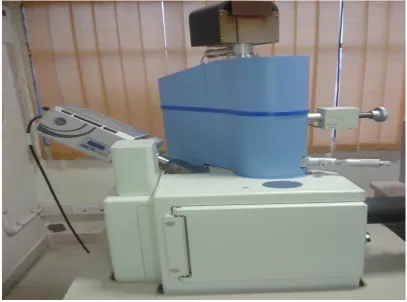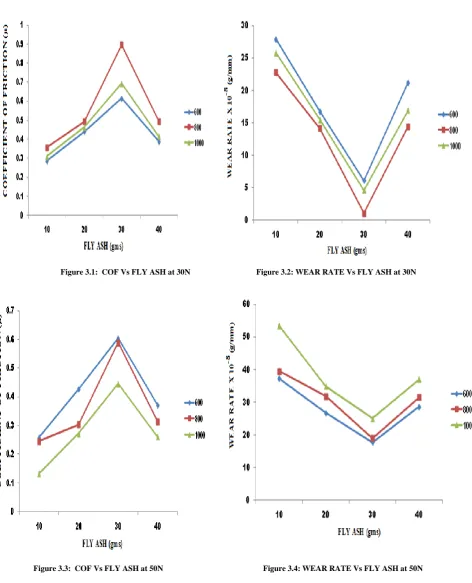Copyright to IJIRSET www.ijirset.com 1
EFFECT OF LOAD AND SPEED ON WEAR
PROPERTIES OF Al 7075-FLY ASH COMPOSITE
MATERIAL
Deepak Singla
1, S.R. Mediratta
2Research Scholar, Dept. of Mechanical Engineering, YIET/KUK, Jagadhri (Yamunanagar), Haryana, India1
Professor, Dept. of Mechanical Engineering, YIET/KUK, Jagadhri (Yamunanagar), Haryana, India2
Abstract: In the present paper we experimentally investigate the effects of load and sliding speed on the friction coefficient and wear properties of pin of Al 7075-Fly Ash composite material on Pin on Disc apparatus. Composites are most successful materials used for recent works in the industry. Metal composites possess significantly improved properties including hardness and wear resistance compared to alloys or any other metal. Hence composites with fly ash with Al 7075 as reinforcement are optimizes the different physical and mechanical properties which widely used in the automotive and space craft applications.
Keywords: Al 7075, Fly Ash, Coefficient of Friction, Wear Rate, Load, Sliding Speed, Scanning Electron Microscope
I. INTRODUCTION
The particulate reinforced aluminium composites are gaining importance now the days because of their low cost with advantages like isotropic properties and the possibility of secondary processing facilitating fabrication of secondary components. Cast aluminium matrix particle reinforced composites have higher specific strength, specific modulus, hardness and good wear resistance as compared to unreinforced alloys.
In the present work, fly-ash which mainly consists of refractory oxides like silica, alumina, and iron oxides is used as reinforcing phase. Composite was produced with 10gm to 40gm fly-ash as reinforcing phase. In this work we investigate the effects of normal load and sliding speed on the coefficient of friction and wear properties of Al 7075-Fly Ash composite material on Pin on Disc apparatus against a mild steel disc. After that we also made the microstructure study of the wear pin on the Scanning Electron Microscope apparatus which shows the condition of surface of all composite pins to judge the wear effects. These aspects have been discussed by many researchers:
Copyright to IJIRSET www.ijirset.com 2
II. EXPERIMENTAL WORK
A. Sliding Wear
A cylindrical pin of size 10mm diameter and 40mm length were prepared for all compositions of Al 7075-Fly Ash composite material and after that tested on the Pin on Disc apparatus which connects directly with computer. Table 2.1 shows the composition of Al 7075-Fly Ash composite material. Figure 2.1&2.2 shows the Pin on Disc wear testing machine and the specimen of all compositions respectively. Before testing the surface of the all specimens was polished with the help of 1000 grit paper. All the wear tests were carried out at the room temperature having relative humidity 60% for. The rotating disc was made of mild steel. These tests were carried out at different speeds and normal load conditions. Here we varied the load at 30N, 50N, 70N and speed at 600rpm, 800rpm,1000 rpm for 5 minutes. Wear rate can be calculated by the formula:
WR= (w1-w2)
/
2πrntTable 2.1: Composition Used For Metal Matrix Composite
No. of
Samples
Aluminium(7075)
(gm)
Magnesium
(gm)
Fly Ash
(gm)
Total Weight
(gm)
S1
500
10
40
550
S2
500
20
30
550
S3
500
30
20
550
S4
500
40
10
550
Copyright to IJIRSET www.ijirset.com 3 Figure 2.2: Specimen for Wear Test
B. Microstructure Analysis
Scanning Electron Microscope(SEM) was used to analyze the wear surface profile to decide the wear mechanism of all compositions. First of all, for proper testing on SEM these specimens were manually polished by an etchant. Figure 2.3 shows the picture of JEOL JSM-6610LV SEM machine.
Figure 2.3: JEOL JSM-6610LV Scanning Electron Microscope
Copyright to IJIRSET www.ijirset.com 4 Table 3.1: Experimental values of COF and Wear Rate for Sample1
Table 3.2: Experimental values of COF and Wear Rate for Sample2
LOAD
30 N
50 N
70 N
SPEED (rpm)
600
800
1000
600
800
1000
600
800
1000
Coefficient Of
Friction(µ)
0.615
0.896 0.693
0.604
0.589 0.446 0.325 0.225
0.178
Wear rate
*10
-8(gm/mm)
6.10
1.06
4.60
17.71
18.99 25.06 25.70 41.85
56.09
In the present work, we were examined the coefficient of friction and wear rate of composite pins as a function of fly ash content at various load and sliding speed conditions against the high carbon alloy steel(EN-31) disc. Various experimental data of COF and wear rate are tabulated in the form of table (3.1-3.4) and also the table 3.5 for hardness of Al 7075- Fly Ash composites [3]. These tables show the COF and rate of wear of composite pins at different load and speed conditions. Wear resistance of the Al 7075-Fly Ash composites is increased as of fly ash content increased.
Figure (3.1&3.2) shows the graph between COF and wear rate Vs fly ash content respectively at load conditions of 30N and at various sliding speed as on 600rpm, 800rpm & 1000 rpm. From figure 3.1, we observed that as of we increases the fly ash content the value of COF improves but up to the some incorporation of reinforcing material after that it decreases. In this fig. we observed COF at diff. speeds 600,800 & 1000 rpm. As the sliding speed increases initially from 600rpm to 800rpm the value of COF for various values of fly ash content also increases in great extent due to of oxide layer and mechanical mixing layer (MML). As the sliding speed increases, the surface of mild steel reacts to form ferrous oxide along with aluminium oxide
LOAD
30 N
50 N
70 N
SPEED (rpm)
600
800
1000
600
800
1000
600
800
1000
Coefficient Of
Friction(µ)
0.390
0.495 0.416 0.372 0.315 0.261 0.242 0.122
0.086
Wear rate
*10
-8(gm/mm)
Copyright to IJIRSET www.ijirset.com 5 Table 3.3: Experimental values of COF and Wear Rate for Sample3
LOAD
30 N
50 N
70 N
SPEED (rpm)
600
800
1000
600
800
1000
600
800
1000
Coefficient Of
Friction(µ)
0.441
0.493 0.463 0.427 0.303
0.272 0.253 0.194 0.163
Wear rate
*10
-8(gm/mm)
16.78
14.17 15.49 26.70 31.80
34.93 37.10 53.22 57.69
Table 3.4: Experimental values of COF and Wear Rate for Sample4
LOAD
30 N
50 N
70 N
SPEED (rpm)
600
800
1000
600
800
1000
600
800
1000
Coefficient Of
Friction(µ)
0.287
0.357 0.312 0.257 0.245
0.132 0.229 0.180 0.129
Wear rate
*10
-8(gm/mm)
27.90
22.74 25.80 37.20 39.45
53.34 41.40 54.84 63.05
Table 3.5: Experimental Data for Hardness of Al 7075-Fly Ash Composites
Samples
S1
S2
S3
S4
Hardness(HRB)
70
77
75
68
and MML b/w the composite pin and mild steel disc was formed. It is obvious that the work hardening of the Al occurs during the sliding action and the formation of oxide layer on the surface of the pin enhances the wear resistance. But from 800rpm to 1000 rpm the value of COF decreases due to the thermal softening effect b/w pin and disc which smash out the oxide layer. Acc. to the behavior of the COF as of it increases initially and after that go down, the wear rate first decreases and then suddenly increases as shown in fig. 3.2.
Copyright to IJIRSET www.ijirset.com 6
in fig. 3.4. The same results are tabulated when graphs b/w COF and wear rate Vs fly ash plotted at load conditions of 70N due to the same effect of thermal softening of Al which lowers the bond b/w Al and ash content as shown in figure (3.5&3.6).
Figure 3.1: COF Vs FLY ASH at 30N Figure 3.2: WEAR RATE Vs FLY ASH at 30N
Copyright to IJIRSET www.ijirset.com 7 Figure 3.5: COF Vs FLY ASH at 70N Figure 3.6: WEAR RATE Vs FLY ASH at 70N
The obtained results are in line with the other researchers [2]. By superimposing the fig. 3.2, fig.3.4 & fig.3.6, it can be observed that the wear rate of the Al 7075- Fly Ash composites increases as the load increases from 30N to 70N and also the trend in wear resistance can be found to be increasing with increase of ash content in the composites. This increase in wear resistance of the composite is due to the reason of the reinforcement material fly ash which is much harder than the matrix material Al. This increase in wear resistance can also be attributed to a better interfacial bonding b/w Al and fly ash particles thus helps in preventing the damages caused due to the sliding action. Incorporation of 30gm fly ash to the Al matrix was very effective in reducing the wear loss due to the strong interfacial bond which transferring the load from Al matrix to the ash content as these are harder in nature. As the ash content increases beyond 30gm wear rate increases as load and sliding speed increases. This may be due to clustering of fly ash particles and poor interfacial bonding b/w Al and fly ash particles.
B. Microstructure Analysis of Wear Test Specimen
Copyright to IJIRSET www.ijirset.com 8
3.7(a)FA-10gm 3.7(b)FA-20gm
3.7(c)FA-30gm 3.7(d)FA-40gm
Figure 3.7:Worn surfaces of Al 7075-Fly Ash Composites on different range of Fly Ash (a),(b),(c) &(d) at 70N and 1000rpm
IV. CONCLUSIONS
Here we successfully examined the wear and friction properties of Al 7075-Fly Ash Composites by using Pin on Disc wear testing machine. We have drawn various conclusions from the data of coefficient of friction and wear rate:
a) As we increase the load and speed, the wear rate of composites increases and coefficient of friction decreases. b) Result shows that the coefficient of friction increases as the fly ash content increases and improves the ability
to resist the wear. This is due to the favorable effect of fly ash particles which increases the hardness of composite material up to some range.
c) However the addition of 30gm fly ash particles in the Al 7075 was very effective to improve its ability to resist the material loss.
From the above results we find the Sample2 having a good coefficient of friction and ability to resist a wear for a long time. So that these composites could be used in those sectors where good mechanical and physical properties are required as like in automobile and space industries.
ACKNOWLEDGEMENT
Copyright to IJIRSET www.ijirset.com 9
[1] MAHENDRAI, K.V:- “Fabrication of Al-4.5% Cu alloy with Fly Ash Metal Matrix Composites and its characterization”, materials science- poland, vol 25, issue no.1, pp. 57-68, 2007.
[2] SHANMUGHASUNDARAM, P.:- “Some studies on Aluminium- Fly Ash composites fabricated by two step stir casting method”, european journal of scientific research, vol. 63, issue no.2, pp. 204-218, 2011.
[3] SINGLA, DEEPAK:-“Evaluation of Mechanical Properties of Al 7075-Fly Ash Composite Material”, international journal of innovative research in science, engineering and technology, vol. 2, issue no. 4, pp. 951-959, 2013.
[4] CHOWDHURY, M.A:-“The effect of sliding speed and normal load on friction and wear property of aluminium”, international journal of mechanical and mechatronics engineering, vol. 11, issue no. 1, pp. 53-57, 2011.
[5] AMEEN, HANI AZIZ:-“Effect of loads, sliding speeds and times on the wear rate of different material”, American journal of scientific and industrial research, vol. 2, issue no. 1, pp. 99-106, 2011.
BIOGRAPHY




